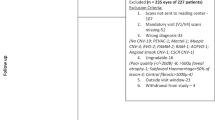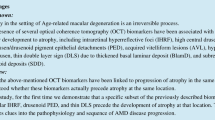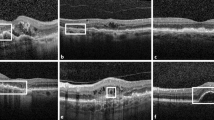Abstract
Purpose
To study the natural history of optical coherence tomography (OCT) imaging-based findings seen in non-exudative age-related macular degeneration (neAMD) and model their relative likelihood in predicting development of incomplete retinal pigment epithelium and outer retinal atrophy (iRORA), complete retinal pigment epithelium and outer retinal atrophy (cRORA), and neovascular AMD (nAMD).
Methods
Retrospective chart review was performed at two academic practices. Patients diagnosed with neAMD for whom yearly OCT scans were obtained for at least 4 consecutive years were included. Baseline demographic, visual acuity, AREDS staging, and OCT data were collected. OCTs were assessed for the presence or absence of eleven features previously individually associated with progression of neAMD, both at baseline, and on all subsequent follow-up scans. Likewise, charts were reviewed to assess visual acuity and staging of NEAMD at all follow-up visits. A multivariate regression analysis was constructed to determine predictors of iRORA, cRORA, and nAMD.
Results
A total of 107 eyes of 88 patients were evaluated. Follow-up included yearly OCTs obtained over at least 4 consecutive years follow-up (range: 50–94 months). During the follow-up period, 17 eyes progressed to iRORA while 25 progressed to cRORA and 16 underwent conversion to nAMD. Predictors of conversion to iRORA and cRORA included integrity of the external limiting membrane (p = 0.02), the ellipsoid zone (p = 0.01), and the cone outer segment line (p = 0.003) and the presence of intraretinal hyporeflective spaces (p = 0.009), drusen ooze (p = 0.05), and drusen collapse (p = 0.001). OCT features predictive of conversion to nAMD included outer nuclear layer (ONL) loss (p = 0.01), presence of intraretinal (p = 0.001) and subretinal (p = 0.005) hyporeflective spaces, and drusen collapse (p = 0.003).
Conclusion
Of these multiple factors predictive of progression of neAMD, the OCT feature most strongly correlated to progression to iRORA/cRORA was drusen collapse, and the feature most predictive of conversion to nAMD was the presence of intraretinal hyporeflective spaces.




Similar content being viewed by others
Data availability
Available upon request.
Code availability
Available upon request.
References
Bird AC, Bressler NM, Bressler SB et al (1995) An international classification and grading system for age-related maculopathy and age-related macular degeneration. Surv Ophthalmol 39(5):367–374
Holeman IC, Aul B, Pak JW et al (2019) Precursors and development of geographic atrophy with autofluorescence imaging: age-related eye disease study 2 Report Number 18. Ophthalmol Retina 3(9):724–733
Nassissi M, Fan W, Shi Y et al (2018) Quantity of intraretinal hyperreflective foci in patients with intermediate age-related macular degeneration correlates with 1-year progression. Invest Ophthalmol Vis Sci 59(8):3431–3439
Spaide RF, Yannuzzi L, Freund KB, Mullins R, Stone E (2019) Eyes with subretinal drusenoid deposits and no drusen: progression of Macular Findings. Retina 39(1):12–26
Fraggiotta S, Fernandez-Avellaneda BMP et al (2019) The fate and prognostic implications of hyperreflective crystalline deposits in nonneovascular age-related macular degeneration. Invest Ophthalmol Vis Sci 60(8):3100–3109
Jhingan M, Singh SR, Samanta A et al (2021) Drusen ooze: predictor for progression of dry age-related macular degeneration. Graefes Arch Clin Exp Ophthalmol. https://doi.org/10.1007/s00417-021-05147-7
Schmidt-Erfurth U, Waldstein SM (2016) A paradigm shift in imaging biomarkers in neovascular age-related macular degeneration. Prog Retin Eye Res 50:1–24
Freund KB, Zweifel SA, Engelbert M (2010) Do we need a new classification for choroidal neovascularization in age-related macular degeneration? Retina 30:1333–1349
Kumar JB, Wai KM, Ehlers JP, Singh RP, Rachitskaya AV (2019) Subfoveal choroidal thickness as a prognostic factor in exudative age-related macular degeneration. Br J Ophthalmol 103:918–921
Ferris FL, Wilkinson CP, Bird A et al (2013) Clinical classification of age-related macular degeneration. Ophthalmol 120(4):844–851
Guymer RH, Rosenfeld PJ, Curcio CA et al (2020) Incomplete retinal pigment epithelial and outer retinal atrophy in age-related macular degeneration: classification of atrophy Meeting Report 4. Ophthalmol 127(3):394–409
Sadda SR, Guymer R, Holz FG et al (2018) Consensus definition for atrophy associated with age-related macular degeneration on OCT: classification of atrophy Report 3. Ophthalmol 125(4):537–548
Jaffe GJ, Chakravarthy U, Freund KB et al (2020) Imaging features associated with progression to geographic atrophy in age-related macular degeneration: classification of atrophy Meeting Report 5. Ophthalmol Retina S2468–6530(20):30490–30495
Sato T, Kishi S, Wantabe G, Matsumoto H, Mukai R (2007) Tomographic features of branching vascular networks in polypoidal choroidal vasculopathy. Retina 27(5):589–594
Mones J, Garcia M, Biarnes M, Lakkarju A, Ferraro L (2017) Drusen Ooze: a novel hypothesis in geographic atrophy. Ophthalmol Retina 1(6):461–473
Khanifar AA, Koreishi AF, Izatt JA, Toth CA (2008) Drusen ultrastructure imaging with spectral domain optical coherence tomography in age-related macular degeneration. Ophthalmol 115(11):1883–1890
Acknowledgements
Age Related Macular Degeneration Study Group: Amarasekera, Sohani1; Singh, Sumit R2; Samanta, Anindya3; Jhingan, Mahima2; Arora, Supriya4; Tucci, Davide5; Martel, Joseph N1; Friberg, Thomas R1; Gallagher, Denise1; Errera, Marie Helene1; Eller, Andrew W1; Cagini, Carlo5; Sahel, Jose A1; Lupidi, Marco5; Chhablani, Jay1
Affiliations:
1. University of Pittsburgh Medical Center, Pittsburgh, PA, United States.
2. Joan and Irwin Jacobs Retina Center, La Jolla, CA, United States.
3. Texas Tech University Health Sciences Center School of Medicine, Lubbock, TX, United States.
4. Princess Margaret Hospital, Bahamas.
5. Universita degli Studi di Perugia Facolta di Medicina e Chirurgia, Perugia, Umbria, Italy.
Author information
Authors and Affiliations
Consortia
Corresponding author
Ethics declarations
Ethics approval
Ethical approval was waived by the local Ethics Committee of University Pittsburgh in view of the retrospective nature of the study, and all the procedures being performed were part of the routine care.
Consent to participate
Informed consent was obtained from all individual participants included in the study.
Consent for publication
Informed consent was obtained from all individual participants included in the study.
Conflict of interest
The authors declare no competing interests.
Additional information
Publisher's note
Springer Nature remains neutral with regard to jurisdictional claims in published maps and institutional affiliations.
Rights and permissions
About this article
Cite this article
Amarasekera, S., Samanta, A., Jhingan, M. et al. Optical coherence tomography predictors of progression of non-exudative age-related macular degeneration to advanced atrophic and exudative disease. Graefes Arch Clin Exp Ophthalmol 260, 737–746 (2022). https://doi.org/10.1007/s00417-021-05419-2
Received:
Revised:
Accepted:
Published:
Issue Date:
DOI: https://doi.org/10.1007/s00417-021-05419-2




